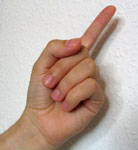This article includes a list of references, related reading, or external links, but its sources remain unclear because it lacks inline citations. Please help improve this article by introducing more precise citations. (March 2024) (Learn how and when to remove this message)
|
Chinese number gestures are a method to signify the natural numbers one through ten using one hand. This method may have been developed to bridge the many varieties of Chinese—for example, the numbers 4 (Chinese: 四; pinyin: sì) and 10 (Chinese: 十; pinyin: shí) are hard to distinguish in some dialects. Some suggest that it was also used by business people during bargaining (i.e., to convey a bid by feeling the hand gesture in a sleeve) when they wish for more privacy in a public place. These gestures are fully integrated into Chinese Sign Language.

While the five digits on one hand can easily express the numbers one through five, six through ten have special signs that can be used in commerce or day-to-day communication. The gestures are rough representations of the Chinese numeral characters they represent. The system varies in practice, especially for the representation of "7" to "10". Two of the systems are listed below:
Use of the signs corresponds to the use of numbers in the Chinese language. For instance, the sign for five just as easily means fifty. A two followed by a six, using a single hand only, could mean 260 or 2600 etc. besides twenty-six. These signs also commonly refer to days of the week, starting from Monday, as well as months of the year, whose names in Chinese are enumerations.
In different regions signs for numbers vary significantly. One may interpret the "8" sign as a "7". The "index finger-hook" symbol for 9, also means "death" in other contexts.
The numbers zero through five are simpler:
Counting with fingers is often different from expressing a specific number with a finger gesture. When counting, the palm can be either facing its owner or the audience, depending on the purpose. Before counting, all fingers are closed; counting starts by extending the thumb as the first, then the index finger as the second, until all fingers are extended as the fifth; then counting can be continued by folding fingers with the same sequence, from thumb through the little finger, for counting from the sixth through the tenth. Repeating the same method for counting larger numbers. One can also starts counting with all fingers extended. Some believe that for formal scenario such as giving speech or presentation, counting with the palm facing the audience and starting with all fingers extended is more polite, since the gesture of folding of fingers representing bowing.
When playing drinking finger games (划拳, 猜拳), slightly different sets of finger gestures of numbers is used. One of them is:
The gesture of the digit 0 is used for showing numbers like 20, 30, 40, etc., where the left hand shows the tens digit and the right hand shows the digit 0.